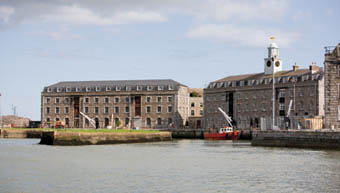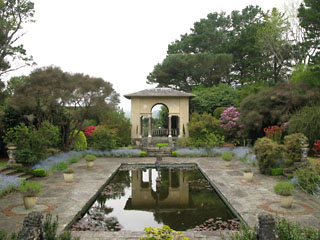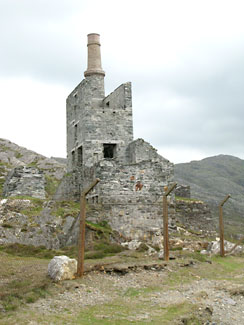Cork


 A particularly good range of shop fronts can be found in Youghal, reflecting the town’s long history as a trading centre. Improved communications and the growth of commercial activity allowed businesses to prosper in the nineteenth and early twentieth centuries. Decorative shop fronts add colour and diversity to streetscapes, demonstrate the skill of local craftsmen and the diversity of contemporary architectural styles. Classical motifs such as quoins, pilasters and stylised brackets add a sense of grandeur to otherwise simple buildings. Gothic influences can be seen in ported arches and ornate tracery, while Arts and Crafts style is seen in richly coloured tiled entrances, decorative brackets and hand-crafted timber.
A particularly good range of shop fronts can be found in Youghal, reflecting the town’s long history as a trading centre. Improved communications and the growth of commercial activity allowed businesses to prosper in the nineteenth and early twentieth centuries. Decorative shop fronts add colour and diversity to streetscapes, demonstrate the skill of local craftsmen and the diversity of contemporary architectural styles. Classical motifs such as quoins, pilasters and stylised brackets add a sense of grandeur to otherwise simple buildings. Gothic influences can be seen in ported arches and ornate tracery, while Arts and Crafts style is seen in richly coloured tiled entrances, decorative brackets and hand-crafted timber.
 The arrival of the French fleet at Bantry Bay in 1796, the failed rebellion of the United Irishmen two years later, and the start of the Napoleonic Wars in 1803 heightened the need for a strategic plan to guard the Irish coastline. A network of signal towers was constructed between 1804 and 1807. Martello towers formed part of the same defensive strategy. Haulbowline Island became an important military base, with the construction of Army barracks to the west side and a Naval supply depot to the east. The Haulbowline depot was the largest of its kind in Ireland, capable of storing enough provisions to maintain the British Navy for one year. Ammunition was stored on Rocky Island in two large vaults capable of holding 25,000 barrels of gunpowder. Ranges of artillery barracks were also constructed on Spike Island.
The arrival of the French fleet at Bantry Bay in 1796, the failed rebellion of the United Irishmen two years later, and the start of the Napoleonic Wars in 1803 heightened the need for a strategic plan to guard the Irish coastline. A network of signal towers was constructed between 1804 and 1807. Martello towers formed part of the same defensive strategy. Haulbowline Island became an important military base, with the construction of Army barracks to the west side and a Naval supply depot to the east. The Haulbowline depot was the largest of its kind in Ireland, capable of storing enough provisions to maintain the British Navy for one year. Ammunition was stored on Rocky Island in two large vaults capable of holding 25,000 barrels of gunpowder. Ranges of artillery barracks were also constructed on Spike Island.
 Ilnacullin or Garinish Island is an architectural and horticultural delight. It was designed by English architect Harold Peto (1854-1933) from 1911-14 for Belfast born business man and Scottish MP John Annan Bryce (1944-1924). Bryce purchased the island from the War Office in 1910 and engaged Peto to design a house and garden which made the most of the island’s astonishingly beautiful setting and its mild micro climate. Though the house was never built, a tea house, boathouse, pavilion, walled garden and garden temple are among the executed garden structures which remain to be enjoyed today, in a lush and verdant setting. Peto’s interest in Italianate garden design and the more contemporary Arts and Crafts movement can be seen throughout the island. A Martello tower, built during the Napoleonic Wars, is reminder of island’s previous strategic importance to the War Office. The island was bequeathed to the Irish nation in 1953 by Bryce’s son Roland, remains in state care, and is open to the public.
Ilnacullin or Garinish Island is an architectural and horticultural delight. It was designed by English architect Harold Peto (1854-1933) from 1911-14 for Belfast born business man and Scottish MP John Annan Bryce (1944-1924). Bryce purchased the island from the War Office in 1910 and engaged Peto to design a house and garden which made the most of the island’s astonishingly beautiful setting and its mild micro climate. Though the house was never built, a tea house, boathouse, pavilion, walled garden and garden temple are among the executed garden structures which remain to be enjoyed today, in a lush and verdant setting. Peto’s interest in Italianate garden design and the more contemporary Arts and Crafts movement can be seen throughout the island. A Martello tower, built during the Napoleonic Wars, is reminder of island’s previous strategic importance to the War Office. The island was bequeathed to the Irish nation in 1953 by Bryce’s son Roland, remains in state care, and is open to the public.
 The copper deposits on the Beara peninsula have been mined since the Bronze Age. It was the nineteenth century however which saw the wide scale exploitation of this resource. A substantial deposit was discovered in 1812 and the Puxley family set about industrialising the extraction process. The engine houses, built by Henry Puxley in 1860 and by Captain James W. Crase, mine manager in the 1870s, are reminders of the technological innovations which were undertaken. These towering structures make a striking contribution to the landscape, while the ruins of related structures contribute greatly to their setting and context. The former Methodist church, now the Berehaven Copper Mines Museum, is a reminder of the social changes which the mining industry precipitated, as it was built for the Cornish miners who brought their expertise and skill to this remote peninsula. Puxley Castle, set outside Castletownbere, was extensively rebuilt and remodelled in the 1860s by Henry Lavallin-Puxley. Its imposing scale, fine architectural detailing and lavish interiors demonstrated the wealth and power of the Puxley family, much of which was the direct result of their mining activities.
The copper deposits on the Beara peninsula have been mined since the Bronze Age. It was the nineteenth century however which saw the wide scale exploitation of this resource. A substantial deposit was discovered in 1812 and the Puxley family set about industrialising the extraction process. The engine houses, built by Henry Puxley in 1860 and by Captain James W. Crase, mine manager in the 1870s, are reminders of the technological innovations which were undertaken. These towering structures make a striking contribution to the landscape, while the ruins of related structures contribute greatly to their setting and context. The former Methodist church, now the Berehaven Copper Mines Museum, is a reminder of the social changes which the mining industry precipitated, as it was built for the Cornish miners who brought their expertise and skill to this remote peninsula. Puxley Castle, set outside Castletownbere, was extensively rebuilt and remodelled in the 1860s by Henry Lavallin-Puxley. Its imposing scale, fine architectural detailing and lavish interiors demonstrated the wealth and power of the Puxley family, much of which was the direct result of their mining activities.